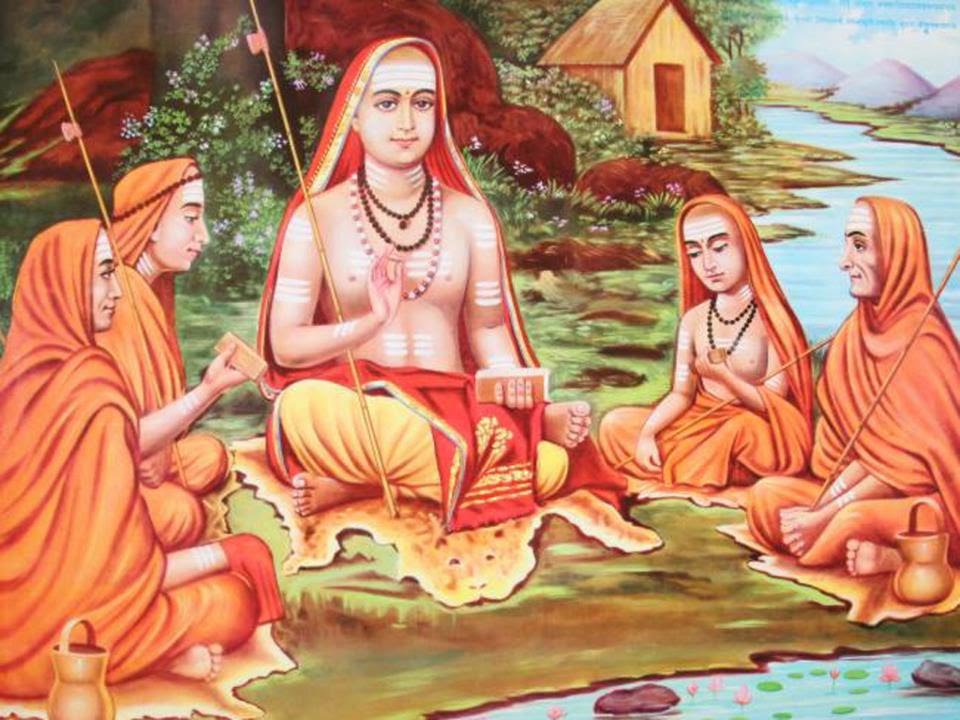ATMA BODHAM “KNOWLEDGE of the SELF” : 25 - Swami Sri Adi Sankaracharya
=================================================================
Sunday, June 21, 2020.7:08. AM.
ATMA BODHAM “KNOWLEDGE of the SELF”
(68 Slokam-s in 9 Chapters)
Chapter - 6 : Slokam-s - 25-37 (13 no.) - “The Birth of the EGO”
A. FEATURES OF THE EGO: (Sloam-s 25-27)
Slokam - 25: The Fundamental Error – Birth of EGO
------------------------------------------------------------------------------------------------------------
Slokam:25.
"Aatmanah sat-chid-amshah cha buddheh vrittih iti dvayam;
samyojya cha avivekena jaanaami iti pravartate. "
-------------------------------------------------------------------------------------------------------------
Translation :
1 Aatmanah sat-chid-amshah cha = The Existence-Consciousness aspect of the Self,
2 buddheh vrittih iti dvayam; = and the thought wave of the intellect –
3 samyojya cha avivekena = by the indiscriminate blending of these two,
4 jaanaami iti pravartate. = there arises the notion of “I know”.
----------------------------------------------------------------------------------------------------------------
Discourse :
Here, Sri Shankaracharya turns again to pure reasoning to present his point, without
resorting to any analogy or simile. The verse aims to help us explain at the level of the mind, that is, to our own intellect, how the Self has come to get identified with the mind. From the standpoint of creation or duality, this explanation gets to the very root of the entire problem of Ignorance and all its ramifications.
We cannot explain this to our mind, because as we have seen in Tattva Bodha, the
mind is not where reasoning, analysis and decisions are taken. Reasoning belongs to the
realm of the intellect. This verse explains at the intellectual level how this false identification takes place. It is quite a fundamental misperception, and any light thrown on this will be of value to disidentify ourselves from the mind, using the intellect as our tool.
Firstly we notice that only Sat and Chid are mentioned; the omission of the Ananda
aspect from the above verse is deliberate. The Ananda aspect can only be studied when the mind is experiencing one of the states known as Priya, Moda and Pramoda. Since this is exceptional rather than the regular state of our experience, we omit it, and look only at the Sat and Chit aspects of the Self.
-----------------------------------------------------------------------------------------------------------
Anyonya (or Itaretara) Adhyaasa: Mutual Superimposition
Vedantic analysts have used this expression to explain what is being described in this
verse. Anyonya Adhyasa means “mutual superimposition”, one upon the other.
An example was given by Acharyaji of a red hot iron ball. This example occurs in this
very text later on in verse 62, but is brought in here to illustrate the principle of mutual
superimposition.
We have two things in this example:
i) Firstly, there is fire, which is red hot but has no solid form.
ii) Secondly, we have an iron ball which has form but no heat.
----------------------------------------------------------------------------------------------------------------
When the two are brought together, the iron ball begins to glow with the heat from
the fire. We can look at this result in two ways:
i) We can say that the iron has taken on the property of the fire and become hot; or,
ii) We can say that the fire has taken on the form of the iron and is now glowing in
the shape of a ball of iron.
This is what is called mutual superimposition in philosophical terms. There is a
transfer of properties in both directions – from ball to fire and from fire to ball. Each object shares its essential characteristic with the other.
------------------------------------------------------------------------------------------------------------
“Unholy Wedlock” – Creation of the False Ego
Pujya Swami Chinmayanandaji used to call the association of the intellect and the Self by the term “unholy wedlock”. This is what the verse is referring to as “indiscriminate blending of the two”. The slokam tells us that such an association has brought about a,misplacing of identity, or a shift in our identity from the Self to a pseudo-Self identified with thoughts. The latter is what we commonly call the ego-self or ego-sense or just Ego.
The unholy wedlock of the intellect and the Self is similar to that of the fire and the ball. Self has Absolute Reality, intellect has only Vyavaharik reality. When the two merge, they become a compact one. They share each other’s qualities. The Sat and Chit aspects of the Self are “I am” and “I know”. The intellect is the instrument of analyzing our thoughts. The marriage results in the thought “I am this thought…” From this, a whole train of thought identification ensues. Due to ignorance and an undeveloped sense of discrimination in the intellect, this resulting thought train is mistaken to be our Self, when it is in fact our pseudo- Self, the Ego.
This is called “indiscriminate blending” in this verse. The philosophical term is
Anyonya Adhyasa.
Then what is “Discriminate blending”?
The next 12 Sloka-s (up to slokam 37) are wholly dedicated to the cultivation of the
power of discrimination in the intellect so that the error referred to in this verse is not made.
CONCLUDED.
-----------------------------------------------------------------------------------------------------
NEXT : Slokam 26: The Deluded Ego Claims to Act and Know
To be continued ...
=====================================================================













Comments
Post a Comment